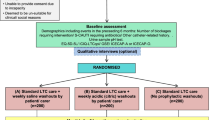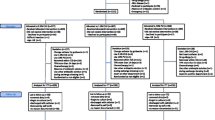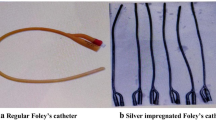Summary
Catheterized patients with heavy bacteriuria and short catheter life received a shortcourse of antimicrobial therapy and then were allocated at random to double-blind treatment for 5 months with methenamine hippurate (MH), 1 g three times daily, or placebo 1 g 3 times daily. MH treatment reduced the number of catheter blockages and instances of spontaneous removal of the catheter, and doubled catheter life (p<0.001). It is suggested that the doubled catheter life was due to the reduced bacteriuria and lowering of urinary pH.
Similar content being viewed by others
References
Boen JR, Markland C, Cass AS (1969) A mathematical comparison of the effects of intermittent and continuous drainage of the bladder on its bacterial count. Invest Urol 6: 383–86
Bremer B, Madsen PO (1972) Route and prophylaxis of ascending bladder infection in male patients with indwelling catheters. J Urol 108: 719–21
Bruce AW, Sira SS, Clark AF, Awad SA (1974) The problem of catheter encrustation. Can Med Assoc J 111: 238–41
Cattell WR, Kelsey Fry I, Spiro FI, Sardeson JM, Sutcliffe MB, O'Grady F (1970) Effect of diuresis and frequent micturition on the bacterial content of infected urine: a measure of competence of intrinsic hydrokinetic clearance mechanisms. Br. J Urol 42: 290–95
Hinman F, Cox C (1966) The voiding vesical defense mechanism: The mathematical effect of residual urine, voiding interval and volume of bacteriuria. J Urol 96: 491–98
Musher DM, Griffith DP (1974) Generation of formaldehyde from methenamine: Effect of pH and concentration and anti-bacterial effect. Antimicrob Agents Chemother 6: 708–11
Musher DM, Griffith DP, Richie Y (1976) The generation of formaldehyde from methenamine. Effect of urinary flow and residual volume. Invest Urol 13: 380–82
Norberg B, Norberg A, Parkhede U, Gippert H (1979) Effect of short-term high-dose treatment with methenamine hippurate on urinary infection in geriatric patients with an indwelling catheter. IV Clinical evaluation. Eur J Clin Pharmacol 15: 357–61
Norrman K, Wibell L (1976) Treatment with methenamine hippurate in the patient with a catheter. J Int Med Res 4: 115–117
Pearman JW, Peterson GJ, Nash JB (1978) The antimicrobial activity of urine of paraplegic patients receiving methenamine mandelate. Invest Urol 16: 91–98
Siegel S (1956) Nonparametric statistics for behavioural sciences. McGraw-Hill, New York
Vainrub B, Musher DM (1977) Lack of effect of methenamine in suppression of, or prophylaxis against, chronic urinary infection. Antimicrob Agents Chemother 12: 625–29
Vermooten V, Berry RV (1933) The effecacy of methenamine as a bactericidal agent in urinary tract infections. N Engl J Med 209: 1332–37
Author information
Authors and Affiliations
Rights and permissions
About this article
Cite this article
Norberg, A., Norberg, B., Parkhede, U. et al. Randomized double-blind study of prophylactic methenamine hippurate treatment of patients with indwelling catheters. Eur J Clin Pharmacol 18, 497–500 (1980). https://doi.org/10.1007/BF00874662
Received:
Revised:
Accepted:
Issue Date:
DOI: https://doi.org/10.1007/BF00874662




